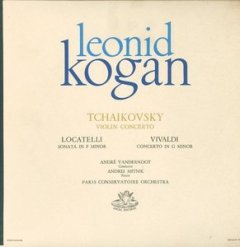The Art Of Leonid Kogan CD6: Tchaikovsky -Violin Concerto Vivaldi -Violin Concerto RV317 Locatelli - Violin Sonata
The Art Of Leonid Kogan CD6: Tchaikovsky -Violin Concerto Vivaldi -Violin Concerto RV317 Locatelli - Violin Sonata

1. Tchaikovsky - Violin Concerto in D, Op.35, I. Allegro moderato (17:38) 2. Tchaikovsky - Violin Concerto in D, Op.35, II. Cazonetta-andante (6:25) 3. Tchaikovsky - Violin Concerto in D, Op.35, III. Finale -allegro vivacissimo (9:03) 4. Vivaldi - Violin Concerto in g, RV317, I. Allegro (5:07) 5. Vivaldi - Violin Concerto in g, RV317, II. Largo (6:42) 6. Vivaldi - Violin Concerto in g, RV317, III. Allegro (3:56) 7. Locatelli - Violin Sonata in f, Op.6-7, I. Largo (3:59) 8. Locatelli - Violin Sonata in f, Op.6-7, II. Grave (1:55) 9. Locatelli - Violin Sonata in f, Op.6-7, III. Vivace (1:58) 10. Locatelli - Violin Sonata in f, Op.6-7, IV. Aria-Cantabile (4:07) Leonid Kogan (violin), Andrei Mytnik (piano) Orchestre de la Societe des Concerts du Conservatoire Andre Vandernoot (conductor)
Tchaikovsky composed this work in 1878. At Clarens, near Geneva, following both his mistake of a marriage and his suicide attempt, Tchaikovsky completed both Onegin and the Fourth Symphony early in 1878. After a round trip to Moscow in February for the symphony's premiere, he was visited at Clarens by the violinist Yosif Kotek. Tchaikovsky, in fondness for Kotek, sketched out a violin concerto in just 11 days and had finished scoring it two weeks later, including a new slow movement in place of one that both Kotek and Tchaikovsky's younger brother, Modest, considered to be weak.
Pyotr Il'yich dedicated the new concerto to Leopold Auer, the fabled Hungarian émigré who would teach two generations of Russian virtuosi. However, just as Nikolai Rubinstein had vilified the B flat minor Piano Concerto four years earlier, Auer declared this new one "unplayable" (though he too recanted, and became one of the work's champions). It was, therefore, a Viennese audience that heard the first performance with Adolf Brodsky and conductor Hans Richter on December 4, 1881. It was an insufficiently rehearsed and poorly accompanied performance, about which Eduard Hanslick wrote, "It brings to us the revolting thought that there may be music that 'stinks in the ear.'" Yet he also wrote in same review that "the concerto has proportion, is musical, and is not without genius."
In addition to its structural soundness, the concerto fairly teems with melodies, in such abundance that the orchestra's gorgeous opening tune never returns! Thereafter the soloist gets first crack at the rest of them, beginning with the "very moderate" principal theme. The second one is marked molto espressivo, after which the main theme returns, before the development section that ends in a showy solo cadenza, followed by the reprise and coda.
The andante Canzonetta ("little song") in 3/4 time with ABA form features a G minor main theme (additionally marked molto espressivo) and a contrastingly quicker, Chopinesque second theme in E flat major. Without pause the next movement lifts off like an SST from the tarmac. It is a Trepak in rondo form, with two extroverted themes of folkloric character, capped by an extended coda that concludes the piece dervishly. No Russian composer before or since Tchaikovsky has ended a concerto with greater finesse or panache, not even Rachmaninov (who learned wherefrom to take his cue early on, with Tchaikovsky's blessing). --- Roger Dettmer, Rovi
In 1729 two sets of six concertos each by Vivaldi, the Opp. 11 and 12, were published in Amsterdam. This G minor effort, the first in the latter group, consists, like the others, of three short movements, with two colorful Allegros framing a lovely central Adagio. The concerto begins with a lively orchestral ritornello, after which the soloist enters to render the opening material in somewhat varied form. Thereafter the orchestra and soloist alternate, though when the latter takes the lead the former demurely supplies colorful accompaniment. The music is sunlit and busy throughout, while the writing offers a few good challenges to the soloist.
The second movement opens with a lovely introduction by the strings, wherein the sense of solemnity and melancholy immediately seize the listener. The soloist then enters with the songful, sad main theme, and while it turns a bit sweeter in the second subject, the resulting mood remains dark and heartrending throughout. The writing for the violin in this panel is consistently touching in its melting lyricism and nocturnal beauty. With the finale the music returns to the brighter world of the opening movement, but with a more hearty, festive character. After the energetic introduction by the strings the soloist enters with the same celebratory vigor, negotiating more than a few technical hurdles along the way. The orchestra and soloist by turns lead the playful proceedings to crown this concerto with a joyful sense of festivity. ---Robert Cummings, Rovi
download (mp3 @320 kbs):
yandex 4shared mega mediafire cloudmailru oboom uplea








